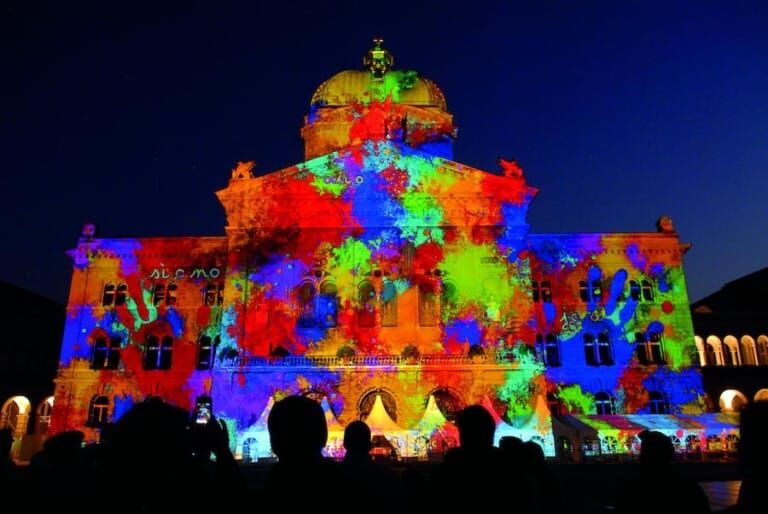by Barco
Until recently, the projection mapping sector had been following a fairly linear path of one-off projections onto buildings at tourist locations or for seasonal or commercial promotions. But lately, more diverse applications have emerged as major drivers. This has changed the business models that are available. What are the ins and outs of these mappings?
Projection mapping projects come in many shapes and sizes. Inevitably, this had led to different funding structures being used. Each model comes with its own constraints and possibilities due to the source of the funding, and the goals and aspirations of the various parties involved.
Funding for projection mapping projects
Public authorities and the element of change
Projection mapping projects and events are often piloted by public authorities and the key to much of this has been public funding. Laurent Lhuillery of Light Event Consulting in Chartres sees a direct link between the amount of funding and the ambitions that a project can aspire to.
In general, the long-term economic development of a town is based on shows with a time span of three to five years. This implies a deep level of creative work and the possible re-development of parts of the show.
“There is no set rhythm,” says Lhuillery. “The pace of change is about the money that can be put into it. If you have elected officials who have the means and who want to change every year, they can do so.”
One of the downsides of public funding is mutating political and cultural landscapes. As the political and economic context can change, so can the expectations and funding of the various partners and local authorities. “There are issues, and there will be change. We know that.”
This is partly why there are fewer recurring mappings in Italy and Spain, where there is nonetheless good growth potential.
“Like France, these countries have a rich architectural heritage,” says Lhuillery. “I’d love to do more work in Rome – can you imagine the stories you could tell there? But the obstacle, in this case, is the reluctance of public authorities to invest.”
This is where ticketed events offer new opportunities.
Commercial enterprises: spotting opportuity
At the opposite end of the scale are projection mapping projects such as those created by Moment Factory, whose advanced storytelling in heritage or protected sites can contribute to their sustainability.
They successfully run a number of ticketed events such as Aura in Montreal, the Lumina walks in different locations and SuperReal in New York. The whole idea is to get people to visit these specific venues. This determines the nature of the relationship between the partners.
The SuperReal show is perhaps the best recent example:
“With the Cipriani venue, we are disrupting the event industry,” says producer Jamie Reilly. “We have an offer of projection mapping that people can use as a flexible digital décor, entertainment, and integrated AV projection into the canvas for their events. And nothing of this scale exists anywhere in North America.
“But in the summertime, nobody hosts events in New York, as everybody is out of town. So then seasonally, we can bring back SuperReal and go into a ticketed experience model. That was really the inspiration of being able to have a multimedia infrastructure that serves multiple purposes.”
Where does the money go?
Immersive events: behind the potential, careful calculations
Although it might seem tempting to launch into immersive events, the stakes are climbing. High-profile events across the world have raised expectations. France’s WB Show has worked with several major projects in China and elsewhere but remains cautious.
“Even though we know the business very well, it is another business model,” says Fabien Moureaud of WB Show in France. “Projects such as the Bassin des Lumières in Bordeaux or Carrières des Lumières the Baux de Provence, require several million euros of investment.”
It’s important to get a good overview of what projection mapping projects can cost before starting. Operators note that the creative side (the actual content creation) is often under-estimated, with up to 20 people working for several months on development. The project must then be adapted to the venue (or venues).
Then, in addition to the technical side, you have to master communication, marketing and online ticketing – all very specific skills.
“Private investors, bankers and investment funds see a business model that is exploding and that is very profitable for people who do their homework well,” adds Moureaud. “It will be our role to accompany the various customers, but not to become a competitor.”
All this underlines the importance of a clear understanding of the goals and potential from the outset.
Ins and outs
The finances around projection mapping projects can be more complex than they first appear. It’s important to consider all the aspects at an early stage of project development.
Sources of funding, support or revenue include public authorities such as tourist offices; local venues and restaurants; ticketing; local entrepreneurs; and cultural enterprises such as museums or landmark monuments. Each source will have its own criteria and requirements that shape the final project.
On the expenses side, the finances will be going towards: the technology; the creative services; marketing and communications costs; ticketing systems and venue rental (if not covered by a partnership).
Although venue and location managers predominantly rent equipment for the duration of the occasional show, some of the locations with permanent mappings are increasingly buying their own equipment.
We will cover the choice between renting and purchasing in our next article.
Top image: Bundesplatz Spectaculaires. Projection mapping powered by Barco. Photo courtesy of Spectaculaires, copyright Jean-Marc Charles.
